A client once asked me, “Can I just use any reefer for meat deliveries?”
I paused because I knew what they were really asking: Is there a cheap option that will “probably” work?
But you and I both know, when it comes to temp-sensitive cargo, there’s no room for “probably.”
Over the past 12 years, I’ve worked with businesses in food transport, mining, and construction. And the one thing I’ve learned? Choosing the right reefer should fit your specific use case, such as your cargo, your route, your conditions.
In this guide, I’ll show you 9 types of reefer trailers, how they’re built, and where they work best. You’ll walk away knowing exactly what to look for.
Let’s start!
Reefer Trailer Quick Comparison
Before we go one by one, it helps to see the big picture. This comparison table shows you the core specs and strengths of each reefer trailer. Then, we’ll walk through each one later so you can find what works best for you.
| Trailer Type | Temp Zones | Temp Range (°F) | Cooling System | Floor Type | Fuel Use (gal/hr) | Best For |
| Single-Temperature Reefer Trailer | 1 | -20 to 70 | Diesel | T-bar or Flat | 0.5 – 1.5 | Long-haul food, frozen goods, general freight |
| Multi-Temperature Reefer Trailer | 2–3 | -20 to 70 | Diesel or Electric | Flat | 1.0 – 1.8 | Grocery delivery, pharma, mixed cargo loads |
| Diesel-Powered Reefer Trailer | 1 | -20 to 70 | Diesel | T-bar or Flat | 0.6 – 1.2 | Rural or remote delivery, long-distance |
| Electric-Powered Reefer Trailer | 1 | -20 to 70 | Electric/Battery | Flat or T-bar | 0 (uses kWh) | Urban delivery, low-emission zones |
| Cryogenic Reefer Trailer | 1 | as low as -238 | Cryogenic (LN2/CO₂) | Flat | 0 (uses gas) | Pharma, biotech, specialty frozen goods |
| Flat-Floor Reefer Trailer | 1 | -20 to 70 | Diesel or Electric | Flat | 0.5 – 1.5 | Dairy, beverages, palletized cargo |
| T-Bar Floor Reefer Trailer | 1 | -20 to 70 | Diesel | T-bar | 0.5 – 1.5 | Frozen food, meat, seafood |
| High-Cube Reefer Trailer | 1 | -20 to 70 | Diesel or Electric | T-bar or Flat | 0.6 – 1.5 | Bulk loads, tall cargo, produce |
| Intermodal Reefer Trailer (Container) | 1 | -85 to 104 | Diesel or Electric | Flat | 0.6 – 1.5 | Global shipping, multi-mode transport |
Now that you’ve seen how they compare, let’s dig into each trailer and find the one that fits your operation best.
1. Single-Temperature Reefer Trailer
I remember talking with a logistics manager who ran long routes from coastal ports to inland cities. He hauled frozen seafood. One time, he tried using a multi-temp reefer, thinking more features meant better performance.
Big mistake.
The complexity didn’t help him. What he needed was something simple. Something reliable. He switched back to a single-temperature reefer and never looked back.
Let’s break down why this type of trailer might be right for you too.
Single-temperature reefer trailer keeps one consistent temperature inside the cargo space.
It doesn’t matter what you’re hauling, meat, dairy, frozen vegetables, or pharmaceuticals. As long as everything inside needs the same temperature, this trailer works.
No compartments. No zones. Just one big space, kept cold from start to finish.
Key Features
Here’s what you can expect:
- One temperature setting across the entire trailer
- Common temperature range: -20°C to +10°C
- Sizes: usually 28ft, 40ft, or 53ft
- Cooling powered by diesel or electric units
- Options for swing or roll-up doors
- Flat or T-bar flooring depending on airflow needs
It’s a simple design, which also means fewer parts that can break.
Who It’s Best For
This trailer fits best if:
- You deliver one type of product per trip
- Your route is long-distance and doesn’t need frequent stops
- You want something easy to maintain
- You don’t want to worry about changing temps for different cargo
Think about cold storage companies, meat suppliers, frozen food distributors, or even manufacturers sending a full load of chilled materials.
Advantages
- Easier to operate
- Lower upfront cost
- Great for full truckload (FTL) shipping
- Less maintenance compared to dual or triple-temp units
Disadvantages
But this type isn’t perfect for everyone.
- You can’t carry mixed-temperature cargo
- It’s less efficient for multi-stop delivery routes
- No flexibility if your load types change often
Still, if you run repeat routes with consistent cargo, why overcomplicate things?
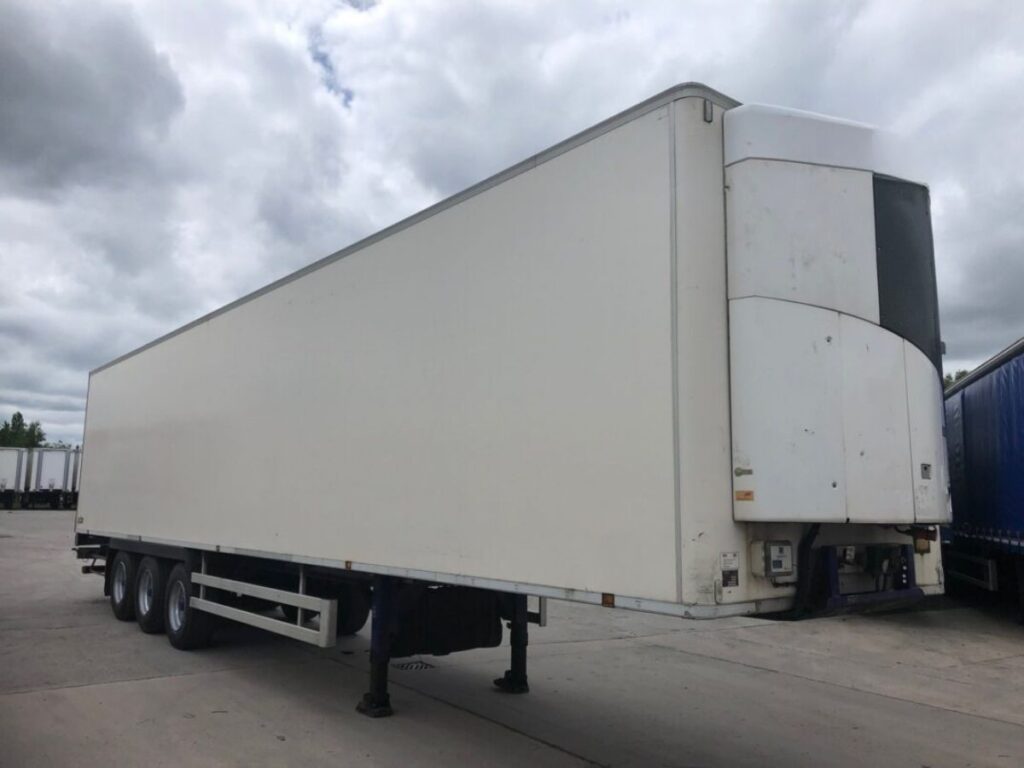
2. Multi-Temperature Reefer Trailer
A few years ago, I met a fleet owner who was juggling frozen meats, fresh fruit, and snack foods. He told me his drivers were running multiple trips just to keep things at the right temperature. One trailer wasn’t enough. Then he switched to multi-temperature reefers, and things changed fast.
If you’re moving mixed cargo on a single route, this type of trailer could save you time, money, and a whole lot of stress.
A multi-temperature reefer trailer is built to carry different kinds of goods at the same time—each at its own temperature.
Instead of one large cold zone, it’s divided into sections. Each section has its own cooling setup. This means you can haul frozen seafood in the back, chilled dairy in the middle, and dry goods up front—all in one trip.
These trailers are popular in:
- Grocery and supermarket delivery
- Food service and catering
- Pharma and medical logistics
- Distribution hubs with multi-stop routes
So how do they work, and what makes them different from other reefers?
Let’s look at the features that matter.
Key Features
Multi-temp reefers come with a lot going on inside. Here’s what you’ll typically find:
- Two or three separate compartments
- Adjustable temperature range from about -20°F to 70°F
- Foam insulation to keep temps steady between zones
- Diesel or electric cooling units (sometimes both)
- Roll-up or swing doors—some models even include side access
- Floor options: flat (easy to clean) or T-bar (better airflow)
- Fuel tanks ranging from 50 to 100 gallons (if diesel-powered)
- Digital control panels for setting and monitoring temps
Now, let’s move to some numbers that help you compare it with other trailers.
Technical Specifications
- Length: Most are 48 to 53 feet
- Height: Usually standard height, but high-cube versions exist
- Interior volume: Varies by model and number of compartments
- Payload: Supports heavy and mixed loads
- Fuel use: Around 0.6 to 1.2 gallons per hour, depending on the setup
- Cooling power: Ranges from 12,000 to 20,000 BTU per hour
- Compatible with: Highway use, fleet logistics, cross-border shipping
Who It’s Best For
This trailer fits your needs if:
- You haul products with different temperature requirements
- Your business involves frequent multi-stop routes
- You want to reduce trips by combining cargo types
Think of food distributors, chain retailers, or any operation where variety is the norm.
Advantages
- Flexibility to transport frozen, chilled, and ambient goods
- Saves money by combining loads
- Useful for high-volume, multi-stop delivery routes
Disadvantages
- More complex to manage than single-temp reefers
- Higher upfront cost
- Additional maintenance due to more components
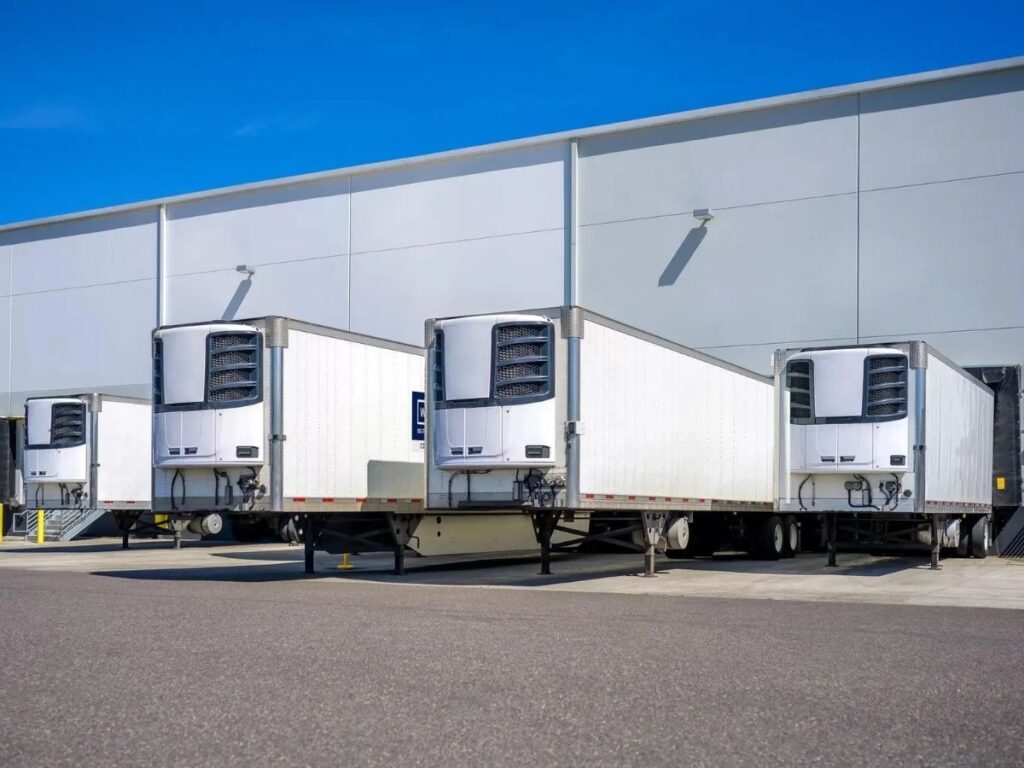
3. Diesel-Powered Reefer Trailer
A few years back, I spoke with a delivery driver who hauled frozen chicken from northern China to inland cities. He said one of his biggest worries wasn’t traffic or road conditions. It was the temperature. If the load thawed even a little, the shipment could be ruined.
That’s why he used a diesel-powered reefer trailer. For him, it wasn’t just about cooling. It was about peace of mind.
If you’re moving perishable goods on long routes or through remote areas, this type of reefer might be what you need.
A diesel-powered reefer trailer uses a separate diesel engine to run the refrigeration unit. This setup lets the trailer keep your cargo cool even when the truck is off or waiting at a dock.
The diesel engine powers a compressor that circulates refrigerant through the cooling system. It removes heat from inside the trailer and helps keep the right temperature steady throughout the trip.
This type of trailer is commonly used in:
- Long-haul food delivery
- Pharmaceutical shipping
- Agriculture and fresh produce transport
- Floral and nursery businesses
Now that you know what it is, let’s look at what makes this trailer work.
Key Features
Diesel reefers come with some helpful features built in:
- One consistent temperature zone
- Cooling range: around -20°F to 70°F
- 3 to 5 inches of foam insulation
- Diesel-powered refrigeration units
- Door options: swing or roll-up
- Flooring: flat or T-bar
- Fuel tanks: usually 50 to 100 gallons
- Digital control panels for temp setting and monitoring
These features are all designed to help you move cold cargo safely and with fewer headaches.
Technical Specifications
Wondering how big or efficient they are? Here’s a quick breakdown:
- Length: commonly 48 ft, 53 ft
- Height: standard or high-cube
- Interior volume: around 3,400 cubic feet
- Payload: up to 24,000 kg or 53,000 lbs
- Fuel use: about 0.6 to 1.2 gallons per hour
- Cooling power: between 12,000 to 20,000 BTU
- Compatible with: highway trailers, container chassis
Who It’s Best For
This type of trailer is a solid choice if:
- You run long-distance routes
- You don’t always have access to electric standby
- You carry high-value or sensitive loads that can’t risk spoilage
Advantages
- Keeps running even when the truck is off
- Handles a wide range of cargo types
- Great for cross-border or rural trips
Disadvantages
Of course, there are trade-offs:
- Higher fuel costs
- More emissions compared to electric options
- Extra maintenance for the engine and cooling system
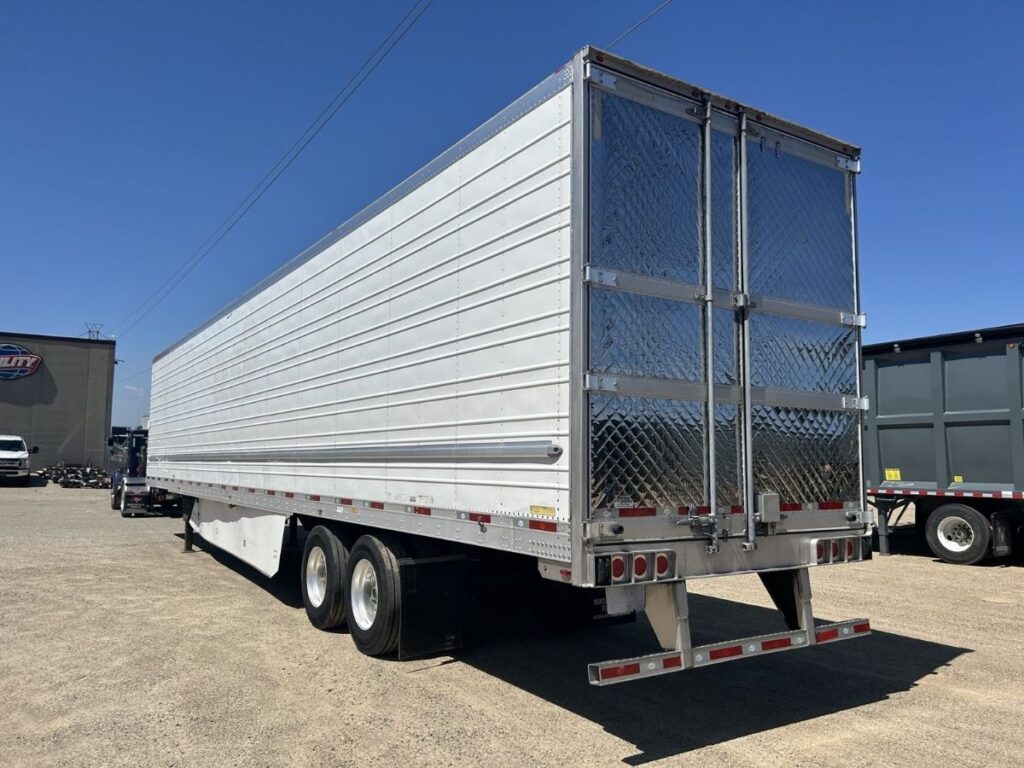
4. Electric-Powered Reefer Trailer
I once met a logistics operator at a trade show who smiled as he told me, “My neighbors don’t even know my truck’s cooling unit is on.” That caught my attention. He was talking about his electric-powered reefer trailer.
He made the switch after getting complaints about diesel noise during nighttime deliveries. What surprised him most wasn’t just the quiet—it was the savings on fuel.
If you’re trying to cut costs, reduce noise, or meet emissions rules, this kind of reefer could be worth a closer look.
An electric-powered reefer trailer uses electricity instead of diesel to run its refrigeration unit.
Some models plug into power while parked, using what’s called shore power. Others run on built-in battery packs while on the road. A few even recharge while driving by collecting energy from braking, kind of like a hybrid car.
These trailers are becoming more popular in:
- Food and beverage delivery
- Pharmaceutical transport
- Urban distribution with strict noise or emissions rules
They’re clean, quiet, and getting more powerful every year.
Key Features
Electric reefers may look like any other trailer from the outside, but inside they’re a bit different:
- One consistent temperature zone
- Temp range from around -20°F to 70°F
- Insulated with thick foam, usually 3 to 5 inches
- Powered by battery or grid electricity (no diesel engine)
- Swing or roll-up rear doors
- Flat floors or T-bar floors depending on airflow needs
- No diesel tank needed
- Digital controls for adjusting and monitoring temperatures
So, what do the numbers look like?
Technical Specifications
Here are some typical specs for electric reefer trailers:
- Length: 48 ft to 53 ft
- Height: standard or high-cube
- Interior space: roughly 3,400 cubic feet
- Payload: up to 45,000 pounds
- Energy use: usually 0.5 to 1.5 kilowatt-hours per hour
- Cooling power: between 12,000 to 20,000 BTU
- Works best for: highway use, short-range delivery, and city routes
Who It’s Best For
Ask yourself: Do you operate in areas with noise restrictions? Are fuel costs eating into your profits?
If so, this reefer could be a smart fit. It’s ideal for:
- City deliveries
- Companies with sustainability goals
- Short- to medium-range transport operations
Advantages
- No diesel = no emissions
- Quiet enough for residential or nighttime stops
- Lower fuel and maintenance costs over time
Disadvantages
Of course, there are a few things to think about:
- You’ll need charging access
- Battery range is limited for long hauls
- Higher purchase price upfront
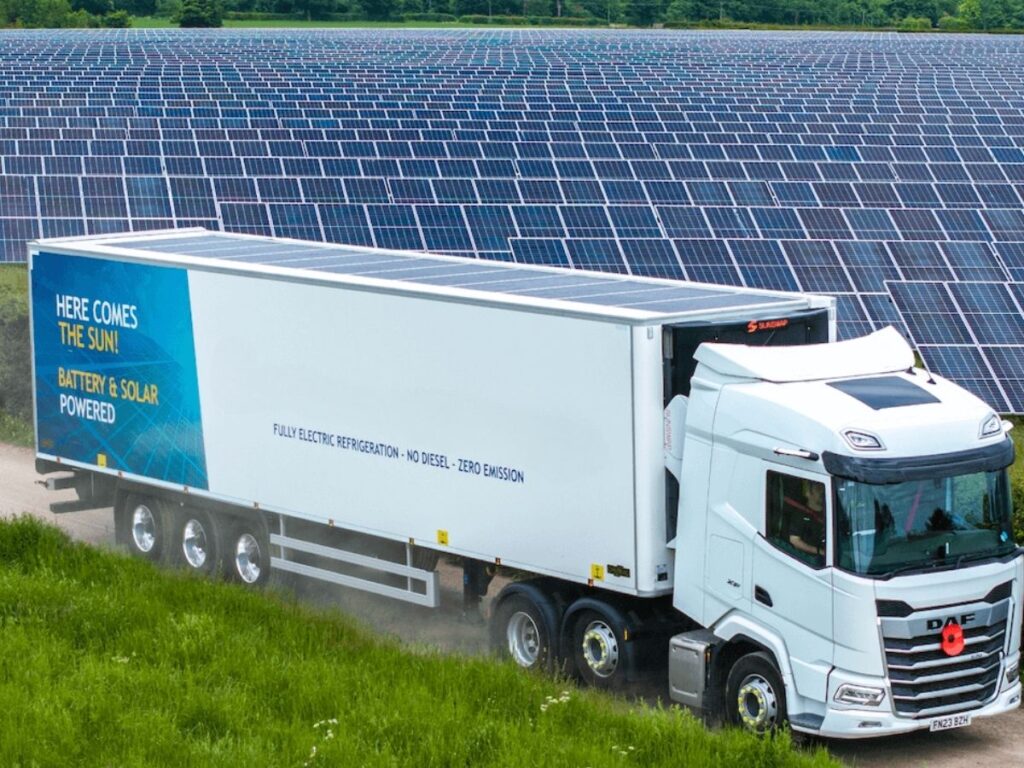
5. Cryogenic Reefer Trailer
I once spoke with a transport coordinator handling lab samples for a medical research center. She told me the biggest challenge wasn’t the distance or the schedule, it was the temperature. Some of her shipments needed to stay far below freezing. Traditional refrigeration couldn’t handle it. That’s when she started using cryogenic reefer trailers.
If you’re hauling products that demand ultra-low temps and steady climate control, this type of trailer might be the right choice for you too.
A cryogenic reefer trailer is a refrigerated unit that uses cryogenic liquidslike liquid nitrogen or carbon dioxide to keep the cargo cold.
Instead of using a mechanical compressor and diesel engine, it cools through a chemical process. The liquid absorbs heat as it turns into gas, which helps keep the trailer’s temperature stable. No engine. No moving parts.
This cooling method is especially useful in:
- Pharmaceutical transport
- Frozen food logistics
- Lab and research shipments
Let’s explore what makes these trailers different from the rest.
Key Features
Because cryogenic reefers are built for specialized loads, their features are a little different:
- Single temperature zone
- Temp range can reach as low as -150°C
- Thick insulation using polyurethane foam
- Cooled by cryogenic liquid, not fuel
- Swing or roll-up rear doors
- Flat or T-bar flooring options
- No diesel tank required
- Digital control panel for easy temp monitoring
Technical Specifications
Here’s what you’ll usually find in terms of size and capacity:
- Length: 28 ft, 40 ft, or 53 ft
- Height: standard or high-cube
- Volume: around 2,000 to 3,500 cubic feet
- Payload: up to 45,000 pounds
- Fuel usage: none (uses cryogenic liquid instead)
- Cooling power: varies, but effective for ultra-cold transport
- Works best on: highways, standard chassis, cross-border routes
Who It’s Best For
Ask yourself: are you moving cargo that must stay cold for long hours without power? Does your cargo include vaccines, blood, or frozen goods?
This reefer is a good fit for:
- Medical and pharmaceutical companies
- Cold storage providers
- Specialty food exporters
Advantages
- Consistent and precise temperature control
- No engine noise during operation
- Less mechanical maintenance required
Disadvantages
But there are trade-offs:
- You’ll need a steady supply of cryogenic liquid
- Handling the gas requires training and safety steps
- Not every region offers refueling or support
Still, if your product can’t risk even a slight temperature change, this might be the safest way to go.
Sometimes, peace of mind is worth the extra effort.
If you’re looking for custom reefer trailers built to match your exact route, cargo, and climate, Rhinotrail can help. We build more than just reefers, we create solutions for every haul.
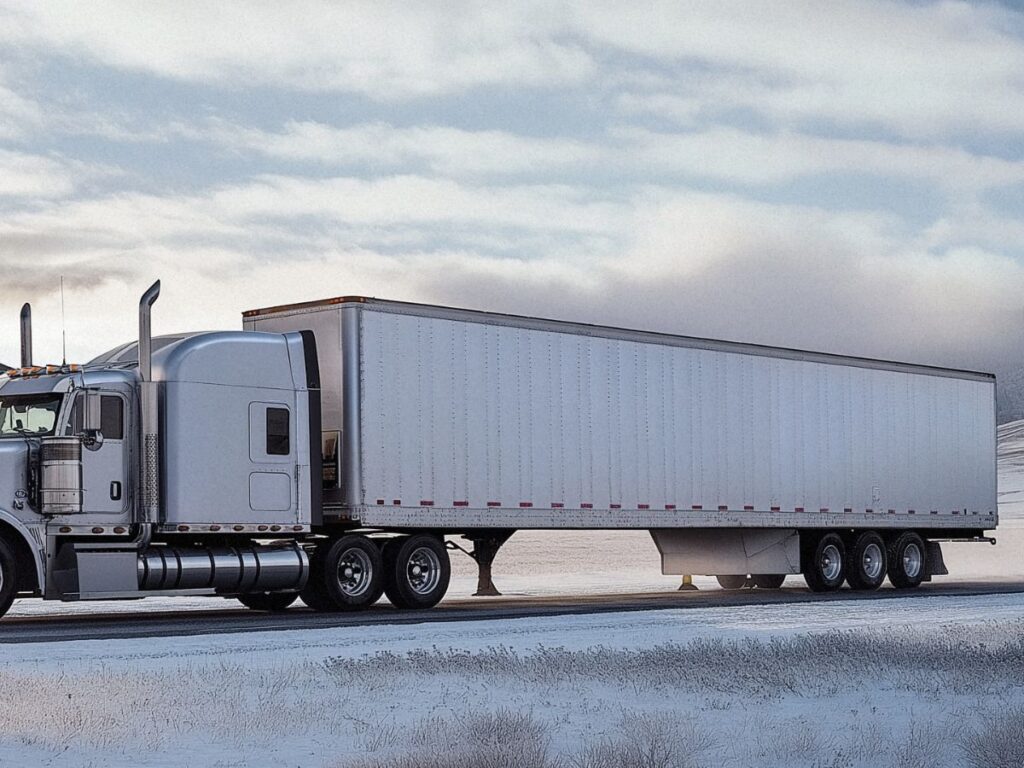
6. Flat-Floor Reefer Trailer
A few months ago, I spoke with a driver who handles daily supermarket deliveries. He said his old trailer had those raised, grooved floors which are good for airflow, sure but terrible for rolling in pallet jacks. “I had to fight every load,” he told me. Then he switched to a flat-floor reefer trailer, and things got easier fast.
If you’re moving boxed, stacked, or palletized cargo, this type of reefer can really make a difference.
A flat-floor reefer trailer is a refrigerated trailer with a completely level surface inside. No grooves. No ridges.
The cooling still works the same as in a regular reefer, but instead of air flowing under the cargo, it circulates around it. That makes it easier to load and unload especially if you’re using forklifts or hand jacks.
You’ll find these trailers mostly used in:
- Dairy transport
- Beverage delivery
- Packaged food and grocery runs
They’re built for speed and simplicity, especially at busy loading docks.
Key Features
Now that you know what it is, let’s look at the key details that matter:
- One consistent temperature zone
- Can hold temperatures from -20°F to 70°F
- About 3 inches of foam insulation in the walls
- Most are diesel-cooled, but some offer electric options
- Swing or roll-up rear doors
- Flat floor surface (no T-bars)
- Diesel units usually carry 50 to 100 gallons of fuel
- Digital controls let you adjust and monitor the temp easily
This setup keeps your cargo cold while keeping your work simple.
Technical Specifications
Here’s a quick look at typical measurements and performance:
- Length: 48 ft or 53 ft
- Height: standard or high-cube
- Volume: around 3,000 to 3,500 cubic feet
- Payload: up to 45,000 pounds
- Fuel usage: about 0.5 to 1.5 gallons per hour
- Cooling output: 15,000 to 20,000 BTUs
- Compatibility: works best for highway routes and standard trailers
Who It’s Best For
Is speed at the loading dock important to you? Do you move a lot of uniform cargo on pallets?
If yes, this reefer fits well with:
- Food and drink companies
- Grocery distributors
- Delivery fleets with tight schedules
Advantages
- Easier loading and unloading
- Less shifting or tipping during transport
- Great for palletized goods
Disadvantages
But there are a few things to keep in mind:
- Less airflow under the cargo means you’ll need to stack and space loads correctly
- Spills can spread faster on a flat floor and take more effort to clean
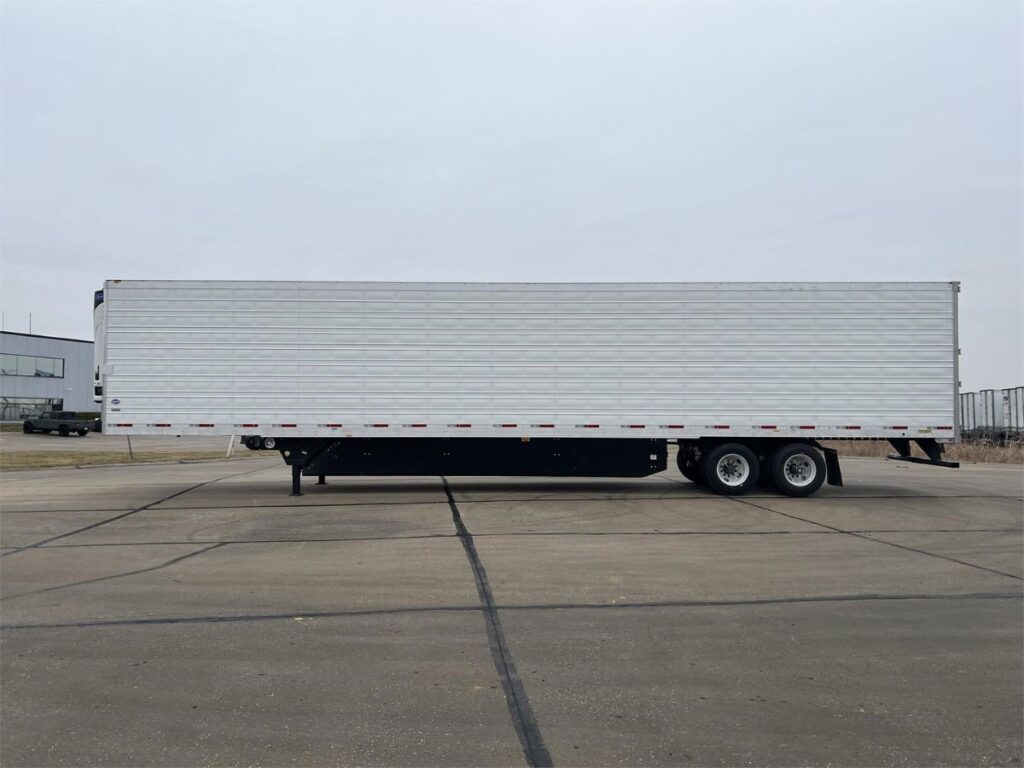
7. T-Bar Floor Reefer Trailer
A T-bar floor reefer trailer is built with raised metal channels running along the floor. These bars create airflow paths underneath the cargo, which helps cold air move evenly from the front of the trailer to the back.
That airflow keeps your cargo at a consistent temperature. It’s especially useful for items that can’t tolerate even small warm spots.
You’ll often find these used in:
- Frozen food distribution
- Seafood and meat hauling
- Ice cream transport
- Long-distance cold chain logistics
Next, let’s break down what this trailer offers in terms of features.
Key Features
Compared to flat-floor reefers, this design adds another layer of performance:
- One consistent temperature zone
- Temperature range from around -20°F to 70°F
- About 3 to 5 inches of polyurethane foam insulation
- Most use diesel cooling systems, though some electric models exist
- Available with swing or roll-up rear doors
- T-bar aluminum flooring for airflow beneath the load
- Fuel tank sizes range from 50 to 100 gallons (for diesel models)
- Digital control panels for easy monitoring and adjustments
Now that you know the features, let’s take a look at the numbers.
Technical Specifications
These trailers usually come in the following formats:
- Length: 28 ft, 40 ft, or 53 ft
- Height: Standard or high-cube
- Interior volume: Around 3,000 to 3,500 cubic feet
- Payload capacity: Up to 45,000 pounds
- Fuel usage: Between 0.5 and 1.5 gallons per hour
- Cooling power: Typically 15,000 to 20,000 BTUs
- Compatible with: Highway use, container chassis, and regional delivery
Who It’s Best For
Are you moving frozen products across long distances? Do you need to reduce temperature swings across the trailer?
If so, this type of reefer is a good match for:
- Frozen food carriers
- Cold storage providers
- Meat and seafood distributors
Advantages
- Better airflow across the entire trailer
- More consistent cooling for temperature-sensitive cargo
- Strong, durable flooring for heavy loads
Disadvantages
- Cleaning can be harder, since debris gets stuck between bars
- Not ideal for hand trucks or pallet jacks without slip sheets
- Slightly more costly than standard flat floors
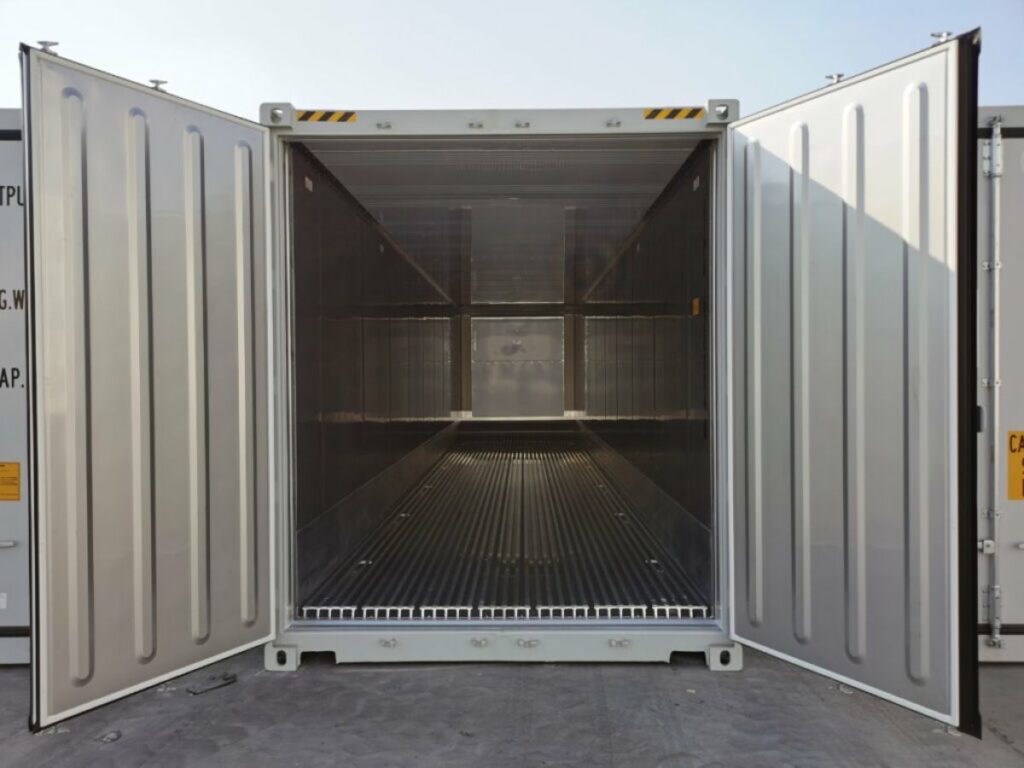
8. High-Cube Reefer Trailer
I once rode along with a produce hauler making deliveries across several provinces. Every stop, he’d open the doors and say the same thing: “We’re tight, again.” His pallets weren’t too wide, just too tall. He needed more space not in length, but in height. Eventually, he moved to high-cube reefer trailers, and things changed fast. No more repacking or turning away product. Just smoother loading, better airflow, and fewer headaches.
If you’ve ever felt like your trailer was just a little too small, this might be the solution.
A high-cube reefer trailer is a refrigerated trailer with extra interior height.
It uses the same cooling systems and structure as a standard reefer, but with more room from floor to ceiling. That extra space helps when you’re hauling tall pallets, stacked goods, or lightweight bulk cargo.
These trailers are commonly used in:
- Produce and fresh food logistics
- Retail distribution centers
- Bulk shipments of boxed or packaged goods
- Long-distance and international freight
If your loads are getting taller or if you want to reduce the number of trips, it’s worth a closer look.
Key Features
What makes this trailer different isn’t just height. It’s how all the parts work together:
- Usually one large temperature zone
- Cooling range from -20°F to 70°F
- Thick foam insulation, around 3 to 5 inches
- Diesel-powered cooling system, with some electric options
- Swing or roll-up rear doors
- Floor: flat or T-bar, depending on airflow needs
- Fuel capacity: 50 to 100 gallons (for diesel units)
- Digital control system for accurate temperature tracking
Now let’s go over the dimensions and performance numbers.
Technical Specifications
Here’s what you can expect with a high-cube reefer:
- Length: 40 ft, 45 ft, or 53 ft
- Height: Interior height often reaches 9.5 ft
- Interior volume: Up to 3,800 cubic feet
- Payload capacity: Around 50,000 pounds
- Fuel usage: Around 0.6 to 1.5 gallons per hour
- Cooling power: Typically 15,000 to 20,000 BTUs
- Compatible with: Highways, container chassis, warehouse loading docks
Who It’s Best For
Do you haul tall or bulky items? Are you running out of space in your current setup?
If yes, this reefer is a good fit for:
- Agriculture and produce haulers
- Retail supply chains
- Companies looking to ship more without increasing trailer count
Advantages
- More vertical space for taller cargo
- Helps reduce the number of trips
- Works well for stacking or light but bulky loads
Disadvantages
- May be too tall for older docks or low-clearance areas
- Slightly heavier trailer, which can impact total payload
- Not ideal if most of your cargo is short and heavy
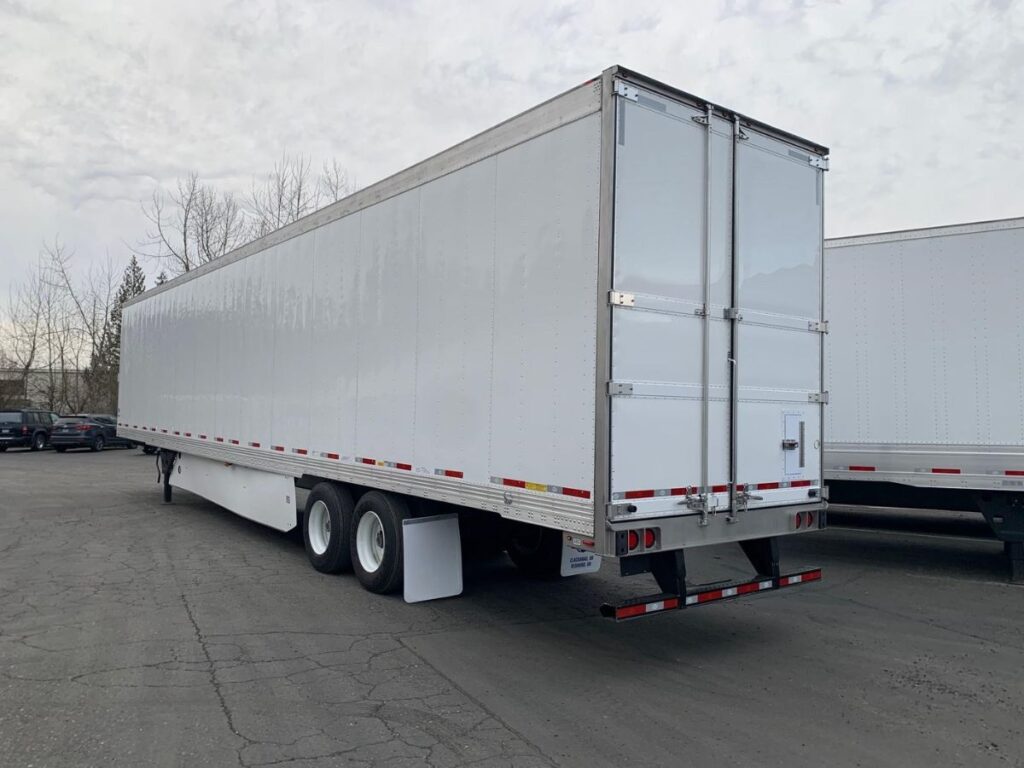
9. Intermodal Reefer Trailer (Container-Based)
An intermodal reefer trailer is a container-style refrigerated unit designed to switch between different types of transportation. That means it can travel by truck, train, and cargo ship without unloading the goods inside.
The cooling system is built right into the container. Most are diesel-powered, though electric and cryogenic options exist too. You’ll see these used in:
- Global food shipments
- Cross-border pharmaceutical deliveries
- Floral and agricultural exports
If you’re moving temperature-sensitive cargo across borders or transport modes, this trailer could be the solution you’ve been looking for.
Key Features
This type of trailer is built for long hauls and multiple transfers. Here’s what you’ll typically find:
- One consistent temperature zone
- Temp range: -65°C to 40°C
- Thick foam insulation to protect from outside heat
- Diesel or electric cooling system
- Swing rear doors
- Flat interior floors
- Diesel tank: usually 50 to 100 gallons
- Digital controls for easy temperature tracking and adjustments
Wondering if the specs match your current operations? Let’s take a look.
Technical Specifications
These units come in a few standard sizes, and most are built to international shipping standards:
- Length: 20 ft, 40 ft, or 45 ft
- Height: Standard or high-cube
- Interior volume: Up to 83 cubic meters (in 45 ft units)
- Payload capacity: Up to 31,000 kg
- Fuel usage: About 0.6 to 1.5 gallons per hour
- Cooling power: Around 15,000 to 20,000 BTUs
- Compatible with: Trucks, ships, trains, and container chassis
Who It’s Best For
Do you ship across long distances or multiple countries? Does your cargo stay on the move for days at a time?
This trailer is ideal for:
- Cold-chain food exporters
- Pharmaceutical supply chains
- Importers and freight forwarders
Advantages
- No need to unload when switching between truck, rail, or ship
- Keeps temperature steady across the entire trip
- Strong and durable for international travel
Disadvantages
- Higher up-front cost than regular reefers
- May require special access to power or refueling
- Not always ideal for short local deliveries
If your shipments travel far and pass through multiple hubs, an intermodal reefer trailer can save you time, reduce handling risks, and help protect your cargo. Sometimes, the fewer times you touch a load, the better it arrives.
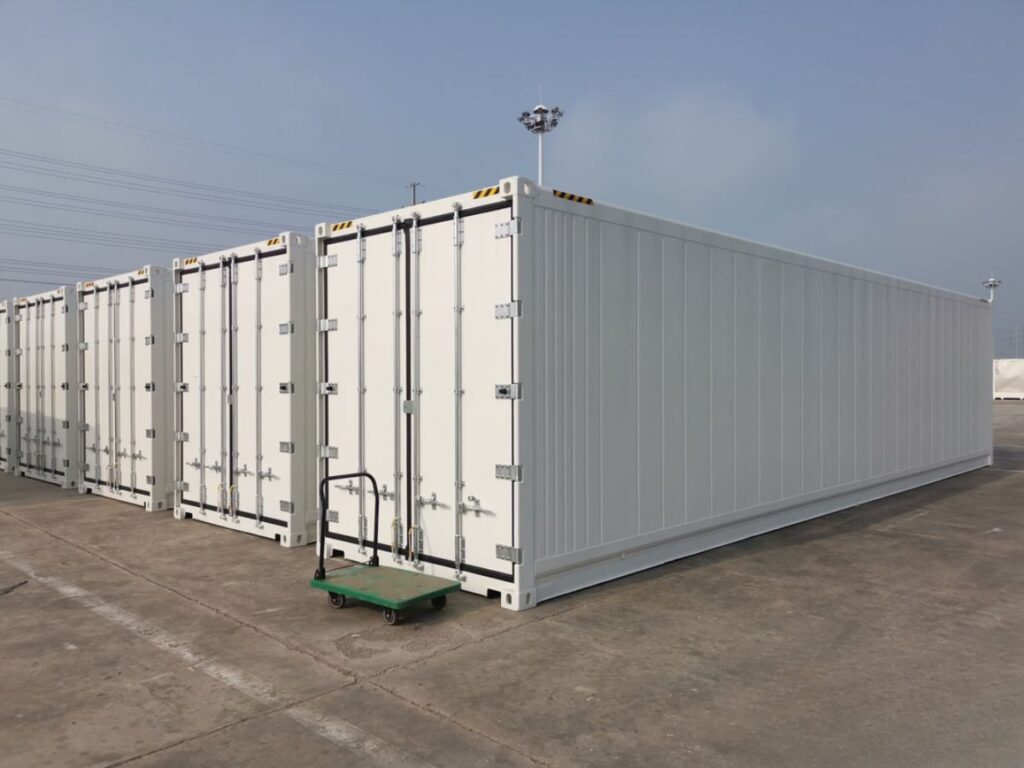
Conclusion
You’ve made it through the complete guide to reefer trailers. That means you care about getting things right.
Each trailer offers something different. And now, you know which one makes sense for your work.
But knowledge alone won’t move your cargo. Action will.
If you’re ready to stop guessing and start hauling smarter, Rhinotrail is ready to build the right trailer with you. Contact us today and let’s get started!
Explore Related Resources
Looking for more product options? Take a look at our carefully chosen selections to find what suits your needs best:
For more in-depth knowledge, take a look at these recommended reads. We think you’ll find them useful:
Still haven’t found what you’re looking for? Don’t hesitate to contact us. We’re available around the clock to assist you.


